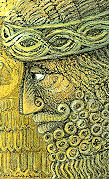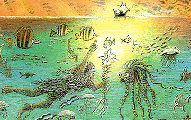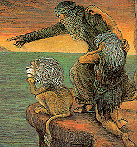


|
The Last Quest of Gilgamesh.
Retold and illustrated by Ludmila Zeman.
Montreal: Tundra Books, 1995. 24pp, cloth,
$19.95.
ISBN 0-88776-328-6.
Grades 4 - 6 / Ages 9 - 11.
Review by Kenneth Field.
|
excerpt:
At the mouth of a river at the end of the earth a man lies, near
death. Could this be Gilgamesh, the all powerful King of Uruk, loved by
his people, famous throughout the ancient world for the magnificent wall
he had built around his city?
What has brought him to this desperate state in this lonely place?
It was the fear of Death. Death had taken his dearest friend,
Enkidu. Earlier it had taken the beautiful Shamhat, whom they both loved.
As Gilgamesh watched their spirits fly off as birds, he resolved to get
rid of Death before it took him from his people. His last quest would be
to find the secret of immortality.
 So begins the last book of the trilogy that retells the ancient
Babylonian epic of Gilgamesh. In the first two books, Gilgamesh
the King and The Revenge of Ishtar, the hero
Gilgamesh, who is half god and half man, learns of human love from his
friends Enkidu and Shamhat, and of the tragic loss of not only his
friends but his people through death. Thus we now find him close to death
himself and yet still struggling against it. The spirit of his friend
Shamhat comes to Gilgamesh to give him guidance in this final struggle.
With her assistance, and renewed strength, Gilgamesh sets out on his
final quest -- to overcome death.
So begins the last book of the trilogy that retells the ancient
Babylonian epic of Gilgamesh. In the first two books, Gilgamesh
the King and The Revenge of Ishtar, the hero
Gilgamesh, who is half god and half man, learns of human love from his
friends Enkidu and Shamhat, and of the tragic loss of not only his
friends but his people through death. Thus we now find him close to death
himself and yet still struggling against it. The spirit of his friend
Shamhat comes to Gilgamesh to give him guidance in this final struggle.
With her assistance, and renewed strength, Gilgamesh sets out on his
final quest -- to overcome death.
Ludmila Zeman's retelling captures this last stage of Gilgamesh's
development -- the realisation that even he will not be able to evade death
attain immortality, but that his memory will live on nonetheless in the
hearts and minds of his people. But for anyone unfamiliar with the epic, there may be some difficulty in piecing
the events recounted in the trilogy together in a way which will give
meaning to the whole story. This will be particularly true for children
to whom the story is read.

The story, as retold by Zeman, flows well, and she incorporates all
of the elements of the epic, such as the
immortal survivors of the flood and the plant of life. But she does not
convey the arbitrary nature of the gods' behaviour in bringing floods or
bestowing immortality on humans. These seemingly unpredictable and
irrational acts were accepted as beyond human understanding in the
ancient world. In this day and age when scientific explanations for
everyday events dominate our lives it is difficult to think of a time
when acts of the gods were viewed as just that.
The illustrations are fashioned after eighteenth- and
nineteenth-century religious engravings. They give the story a biblical
tone which is quite appropriate given the mythic elements, such as the flood,
which recur in the Old Testament. The colouring is beautiful and captures
the changing tones of this last quest very well. (The Last Quest of
Gilgamesh was the 1995 Governor
General's Award-winner for English-language children's
illustration.)

Together, the books in the trilogy are a reasonably accurate
retelling of the Gilgamesh story, and as such are a good introduction
to children to some of the mysteries of the ancient world. The
explanatory notes at the end of the volume provide useful background for
the reader, although a fuller discussion of the meaning of the epic would
be useful, and a map or maps would help to allow the reader to physically locate the
place in which the story originated.
Recommended.
Kenneth Field is a librarian for Traill College at Trent University in
Peterborough, ON.
To comment on this title or this review, send mail to cmeditor@mts.net

Copyright © 1995 the Manitoba Library Association.
Reproduction for personal use is permitted only if this copyright notice
is maintained. Any other reproduction is prohibited without permission.
Published by
The Manitoba Library Association
ISSN 1201-9364
 Go back to CM Welcome page
Go back to CM Welcome page
 Go back to Table of Contents for this Issue
Go back to Table of Contents for this Issue



 So begins the last book of the trilogy that retells the ancient
Babylonian epic of Gilgamesh. In the first two books, Gilgamesh
the King and The Revenge of Ishtar, the hero
Gilgamesh, who is half god and half man, learns of human love from his
friends Enkidu and Shamhat, and of the tragic loss of not only his
friends but his people through death. Thus we now find him close to death
himself and yet still struggling against it. The spirit of his friend
Shamhat comes to Gilgamesh to give him guidance in this final struggle.
With her assistance, and renewed strength, Gilgamesh sets out on his
final quest -- to overcome death.
So begins the last book of the trilogy that retells the ancient
Babylonian epic of Gilgamesh. In the first two books, Gilgamesh
the King and The Revenge of Ishtar, the hero
Gilgamesh, who is half god and half man, learns of human love from his
friends Enkidu and Shamhat, and of the tragic loss of not only his
friends but his people through death. Thus we now find him close to death
himself and yet still struggling against it. The spirit of his friend
Shamhat comes to Gilgamesh to give him guidance in this final struggle.
With her assistance, and renewed strength, Gilgamesh sets out on his
final quest -- to overcome death.

![]()
 Go back to CM Welcome page
Go back to CM Welcome page Go back to Table of Contents for this Issue
Go back to Table of Contents for this Issue